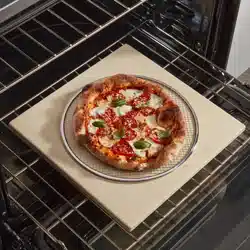
1
SAVE THESE INSTRUCTIONS
Congratulations on your purchase of Cuisinart
®
Cookware! Designed from the inside out
for today’s lifestyles, our Cuisinart
®
Cookware delivers uncompromising superior cooking
performance with a professional look.
BEFORE FIRST USE
Remove all labels and hang tags. Wash screen with warm water. Dry thoroughly before using in
the oven.
CONVENTIONAL OVEN USE
Screen is oven-safe to 700°F. For best results, screen should be coated well first with nonstick
cooking spray. Once coated, shape dough to the pizza screen. Top as desired and then bake.
Always use potholders or a pizza peel when removing the pizza from the oven as screen can still
be hot. Screen can be used in a conventional oven as well as an electric indoor/outdoor pizza
oven.
SERVING
Remove pizza from the screen, and transfer to trivet or wooden board before serving.
COOKING UTENSILS
Do not cut food directly on the screen.
CLEANING AND OTHER MAINTENANCE
Dishwasher safe. Allow screen to cool after use, then rinse screen with warm water. Use a sponge
or a soft cloth to remove any remaining food particles. Rinse thoroughly and dry immediately.
STORAGE
Do not store screen when it is still damp, and always store carefully in a dry cupboard area.
MAKING THE PERFECT PIZZA
Pizza making takes practice. Here are some key steps for success.
Great pizza begins with great ingredients, so opt for best-quality, simple ingredients.
Dough is the foundation of a pizza, and when preparing pan pizza, the dough can vary from style
to style. Store-bought dough is convenient, but for pan pizza, it will not always deliver perfect
results. Our recommendation is to follow our provided recipes for different types of pizzas – we
have simple recipes to prepare everything from focaccia to Detroit style to Chicago deep dish.
If you choose to use store-bought dough or another recipe, this pan needs a minimum of 1½
pounds of dough for a simple focaccia and up to 2½ pounds for thicker Detroit-style pies.
Following these guidelines will ensure the best results.
NOW, ON TO MAKING PAN PIZZA
It’s all about the resting, the stretching, and the resting.
To start, the dough should be at room temperature. This makes it much easier to stretch and
reduces the time needed for stretching.
Once the desired dough is chosen, prepared, and sufficiently rested, transfer it to the deep-
dish pizza pan. Regardless of the type of pizza or focaccia is being prepared, the pan should be
generously coated with a minimum of 4 tablespoons of olive oil.
Put the dough into the pan and turn over a few times to ensure the dough is fully coated with
the olive oil. Using your fingertips, make indentations in the dough without fully pushing through,
being sure to cover the entire surface. While making the indentations, gently press the dough
toward the sides of the pan (do not force it—it will eventually spread). Cover the pan and allow to
rest for 20 minutes.
After resting, uncover and repeat the process, focusing on spreading the dough to the edges of
the pan. Cover and rest for 20 more minutes. Repeat this process until the dough easily covers
the bottom of the pan. This process can take up to 3 rounds (60 minutes total).
From here, the pizza can be topped as desired, whether with additional oil and herbs for a simple
focaccia, or with loads of cheese, sauce, and meat for a Detroit- or Chicago-style pie. Whatever
your preference, we have a guide for all of it.
Remember, if your dough is not stretching as it should (that is, it is too tough or tearing), just let it
rest. After about 10 minutes, try to stretch the dough again. Time does wonders for pizza dough.
When you’re not shaping the dough, keep it loosely covered with plastic to prevent the dough
from drying out.
Chicago Deep Dish: 550°F, 15 minutes
Deep-dish pizza, considered a Chicago specialty, has a crispy crust filled with an ample amount of
sauce, cheese, and other traditional pizza toppings, most commonly sausage and meatballs. The
crust is solely a vessel for the toppings, and this pizza is best eaten with a fork and knife.
12" Pizza
Screen
(continued on next page)
Loading ...
